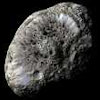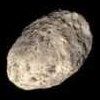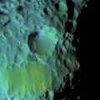Hyperion orbits Saturn in a slightly eccentric orbit with a mean radius of 1,481,009 km (920,250 miles), taking roughly 21¼ days to complete one orbit. Its shape is highly irregular, with the three axis being about 360×266×205 km (224×165×127 miles) giving an average diameter of about 270 km. It is possible that Hyperion is a fragment broken from a larger object following a collision.
Its density is very low, implying that it is composed almost entirely of water ice, with just a small quantity of rocky material. Its coloration suggests that there is a layer of dust on its surface, probably coming from another moon; possibly Phoebe.
Its density is very low, implying that it is composed almost entirely of water ice, with just a small quantity of rocky material. Its coloration suggests that there is a layer of dust on its surface, probably coming from another moon; possibly Phoebe.
Hyperion
Solar System -
Saturn's Moons
This picture comprises a series of images taken using red, green and blue filters were. They were combined to give this natural color view of Hyperion. Cassini took the images from about 291,000 kilometers (181,000 miles) away. It is clear that this is not another grayish moon, but a rather fetching rosy tan color. Some planetary scientists attribute the color to material ejected from the small outer, retrograde orbit moons accumulating on Hyperion's surface; similar to the origin of the dark material on the surface of Iapetus.
This is a color enhanced view of the crater Meri. It is shown towards the bottom of the first image of Hyperion on this page. The various images used to produce this composite were taken from a distance of 17,900 kilometers (11,100 miles) from Hyperion on September 26, 2005.
Cassini took this picture (right) during a flyby on September 26th 2005 from a distance of approximately 62,000 km (38,500 miles). It is a composite using images taken with infrared, green and ultraviolet filters. Thus, while it is a false color image, the detail is astounding as the subtle changes in color across the surface are substantially enhanced.
One reason that the craters appear so crisp and detailed is that, being very porous, when an object hits the moon it tends to compress the surface material rather than blasting it out. As the surface gravity is very low, what material is ejected tends to escape the moon rather than fall back onto the surface.
One reason that the craters appear so crisp and detailed is that, being very porous, when an object hits the moon it tends to compress the surface material rather than blasting it out. As the surface gravity is very low, what material is ejected tends to escape the moon rather than fall back onto the surface.
Saturn's moons are grouped as follows. Select to see details of the moon or the group of moons:
Mimas • Enceladus • Tethys • Dione • Rhea • Titan • Iapetus • Hyperion • Norse Grp • Shepherd Moons • Alkyonides • Inuit Grp • Gallic Grp • Misc




